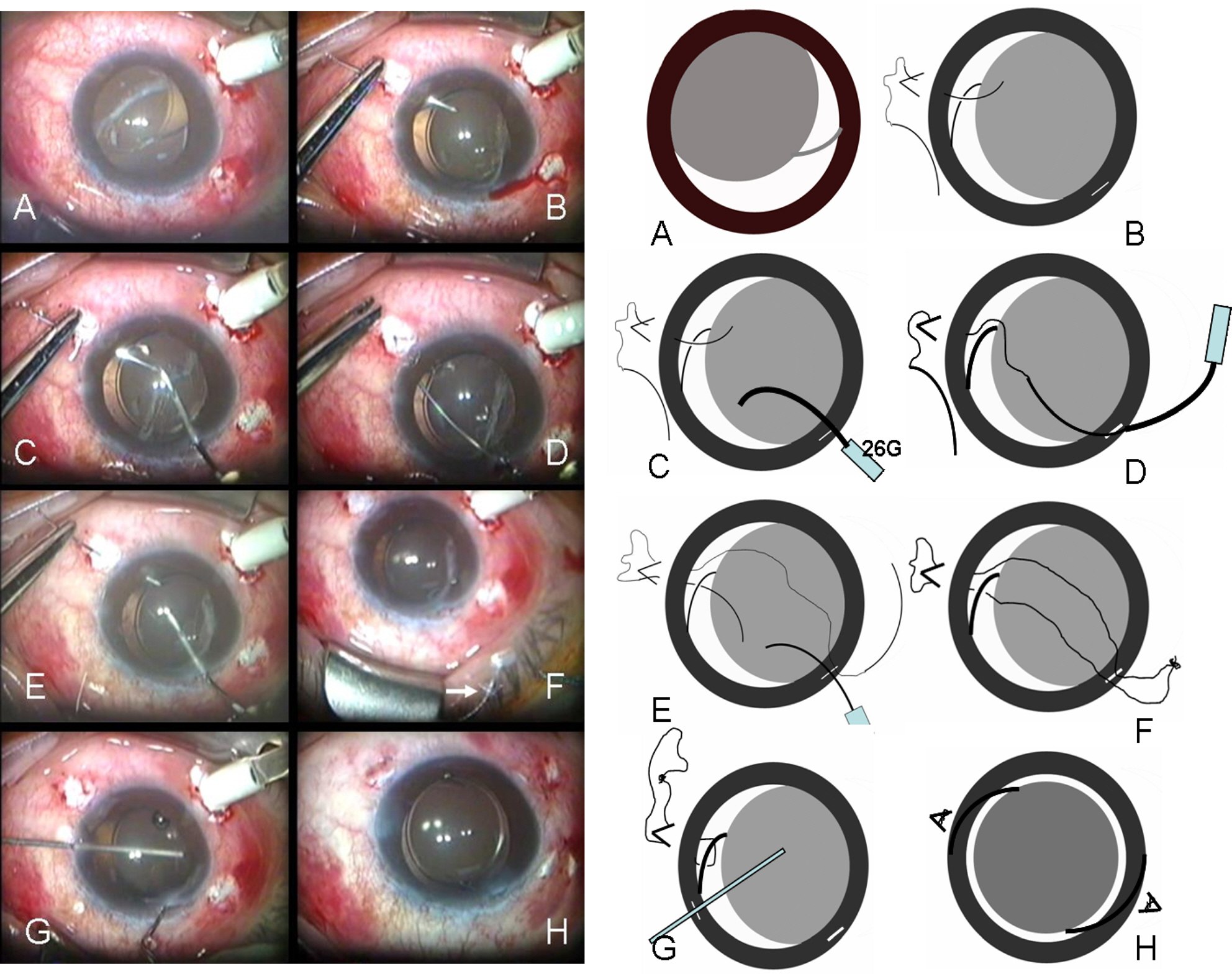J Korean Ophthalmol Soc.
2007 Oct;48(10):1341-1345. 10.3341/jkos.2007.48.10.1341.
A Reverse Ab Externo Scleral Fixation for Posterior Chamber Intraocular Lens Dislocation
- Affiliations
-
- 1Department of Ophthalmology, Soonchunhyang University School of Medicine, Seoul, Korea. wismile@unitel.co.kr
- 2Jung's Eye Clinic, Masan, Korea.
- KMID: 2210987
- DOI: http://doi.org/10.3341/jkos.2007.48.10.1341
Abstract
-
PURPOSE: To report the clinical effects of reverse ab externo scleral fixation with scleral penetration using a 10-0 prolene needle in patients with dislocation of a posterior chamber intraocular lens (PCIOL).
METHODS
The ab externo scleral fixation technique uses a corneal tunnel and a loop of 10-0 propylene made by 2 consecutive scleral sutures to fix the haptic to the sclera. The reverse technique penetrates the sclera with a 10-0 prolene needle instead of a 26-gauge needle and introduces the 26-gauge needle into the corneal tunnel to pull the 10-0 prolene needle through, thus creating a loop around the haptic and fixing it to the sclera. Scleral fixation was performed on one haptic in 2 eyes and on both haptics in 3 eyes.
RESULTS
The dislocated IOLs were successfully repositioned, and the corrected visual acuity was improved postoperatively in all 5 eyes. There was no specific complication except mild hyphema in 1 eye.
CONCLUSIONS
Reversed ab externo scleral fixation is an easy and effective way to reposition dislocated PCIOLs and decrease the complication of hemorrhage and hypotony frequently associated with the standard ab externo technique.
Keyword
MeSH Terms
Figure
Cited by 3 articles
-
Modified Scleral Fixation of Dislocated Posterior Chamber Intraocular Lenses
Deok Goo Lee, Ki Yup Nam, Jung Yeul Kim
J Korean Ophthalmol Soc. 2009;50(7):1071-1075. doi: 10.3341/jkos.2009.50.7.1071.Pars Plana Vitrectomy Combined With Surgical Removal of Anterior and Posterior Capsular Opacity
Hae Jung Sun, Kyung Seek Choi, Sung Jin Lee
J Korean Ophthalmol Soc. 2009;50(9):1341-1347. doi: 10.3341/jkos.2009.50.9.1341.Comparison of Clinical Outcomes after Various Techniques of Intraocular Lens Dislocation Correction
Jae Hong Sun, Jae Yong Kim, Myoung Joon Kim, Young Hee Yoon, Hung Won Tchah
J Korean Ophthalmol Soc. 2014;55(2):196-201. doi: 10.3341/jkos.2014.55.2.196.
Reference
-
References
1. Stark WJ Jr, Maumene AE, Datiles M, et al. Intraocular lenses: complications and visual results. Trans Am Ophthalmol Soc. 1983; 81:280–309.2. Smith SG, Lindstrom RL. Malpositioned posterior chamber lenses: etiology, prevention, and management. J Am Intraocul Implant Soc. 1985; 11:584–91.
Article3. Jehan FS, Mamalis N, Crandall AS. Spontaneous late dislocation of intraocular lens within the capsular bag in pseudoexfoliation patients. Ophthalmology. 2001; 108:1727–31.
Article4. Carlson AN, Stewart WC, Tso PC. Intraocular lens complications requiring removal or exchange. Surv Ophthalmol. 1998; 42:417–40.
Article5. Chan CC, Crandall AS, Ahmed II. Ab externo scleral suture loop fixation for posterior chamber intraocular lens decentration: clinical results. J Cataract Refract Surg. 2006; 32:121–8.
Article6. Koh HJ, Kim CY, Lim SJ, Kwon OW. Scleral fixation technique using 2 corneal tunnels for a dislocated intraocular lens. J Cataract Refract Surg. 2000; 26:1339–41.
Article7. Cho SH, Kang SW, Jung MS. Four cases of modification of scleral fixation using 30 G needle for posterior chamber intraocular lens dislocation. J Korean Ophthalmol Soc. 2002; 43:917–21.8. Smiddy WE. Dislocated posterior chamber intraocular lens; a new technique of management. Arch Ophthalmol. 1989; 107:1678–80.9. Shin DH, Hu BV, Hong YJ, Gibbs KA. Posterior chamber lens implantation in the absence of posterior capsular support. Ophthalmic Surg. 1988; 19:606–7.10. Mensiz E, Aytuluner E, Ozerturk Y. Scleral fixation suture technique without lens removal for posteriorly dislocated intraocular lenses. Can J Ophthalmol. 2002; 37:290–4.
Article11. Sewelam A. Four-point fixation of posterior chamber intraocular lenses in children with unilateral aphakia. J Cataract Refract Surg. 2003; 29:294–300.
Article12. Bardorf CM, Epley KD, Lueder GT, Tychsen L. Pediatric transscleral sutured intraocular lenses: efficacy and safety in 43 eyes followed an average of 3 years. J AAPOS. 2004; 8:318–24.
Article
- Full Text Links
- Actions
-
Cited
- CITED
-
- Close
- Share
- Similar articles
-
- Clinical Results of Modified Ab Externo and One-Knot Technique
- Intraocular Lens Scleral Fixation by Flanged Fixation Using 5-0 Polyprophylene
- Knotless External Fixation Technique for Posterior Chamber Intraocular Lens Transscleral Fixation: A 5-Case Analysis
- Transecleral Suture Fixation for a Posterior Chamber Intraocular Lens Implantation
- Clinical results of a scleral fixation of the posterior chamber intraocular lens, through sclerotomies, 1 mm posterior to the limbus


